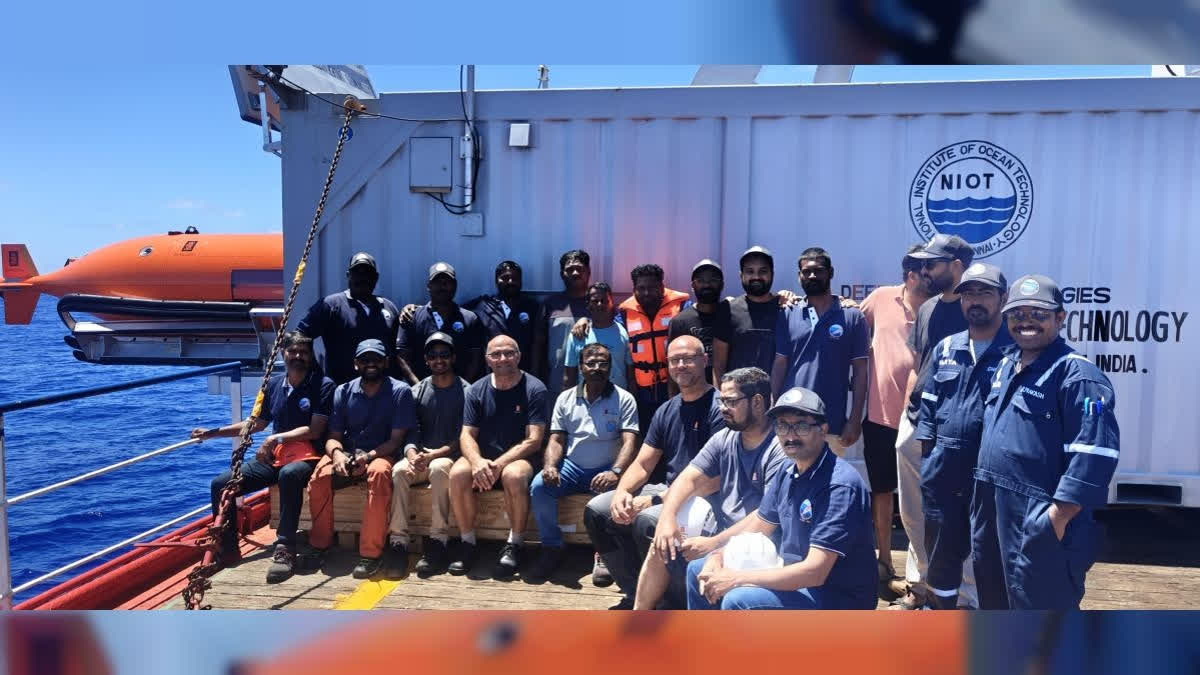Chennai: In a significant stride for Indian deep-sea exploration, scientists from the National Institute of Ocean Technology (NIOT) have made a groundbreaking discovery: active hydrothermal vents located 4,500 meters beneath the surface of the southern Indian Ocean.'
This discovery, achieved through the deployment of an unmanned underwater vehicle (UUV), marks a pivotal moment for India's ambitions in deep-sea mining and scientific research.
Dr NR Ramesh, Chief Scientist and Head, of the Vessel Management Cell, said the mission was carried out in December 2024.
"Under India's Deep Mission Ocean programme, this polymetallic sulphate exploration and exploitation is also part of the programme. So under it, the activity of exploration in an area allotted by the International Seabed Authority to the Government of India. It is in the South West Ridges and Central Indian Ridges in the Southern Indian Ocean," Dr NR Ramesh told ETV Bharat.
According to Dr NR Ramesh, the initial work in this regard was carried out by the National Centre For Polar And Ocean Research, Goa using some vessels.
So, what did the National Institute of Ocean Technology do? Ramesh said that the institution used images of the resources - both living and non-living - which were available and conducted "close-bed bathymetry".
He explained that the non-living resources are in the form of sulphates, which come from the hydrothermal vents.
The operation was carried out onboard Sagarnidhi. Dr NR Ramesh also added that the unmanned underwater vehicle is capable of going to 6,000 meters in the sea. He added that the vehicle was launched from Sagarnidhi in the South West Ridges and Central Indian Ridges and close-bed topography was captured using various equipment.
So what are Hydrothermal Vents?
Hydrothermal vents are underwater hot springs formed in areas of intense volcanic activity, typically along mid-ocean ridges where tectonic plates are diverging. Seawater seeps into cracks in the ocean floor, where it is heated by the underlying magma. This superheated water, laden with dissolved minerals, then erupts from the seafloor, creating towering chimneys that spew plumes of dark, mineral-rich fluids.
Dr S Ramesh, an official of NIOT, on his part, explained about the minerals that are formed in the deep sea. He termed the work done by NIOT as a major breakthrough.
A Treasure Trove of Minerals
These vents are not only geological wonders but also host unique ecosystems. Despite the extreme conditions of high temperature and pressure, a diverse array of life thrives around these vents, including giant tube worms, clams, and other chemosynthetic organisms that derive energy from the chemical reactions occurring at the vents. The mineral-rich deposits surrounding these vents are of significant economic interest. They contain high concentrations of valuable metals such as copper, zinc, gold, silver, and rare earth elements, making them potential targets for future deep-sea mining operations.
India's Deep-Sea Ambitions
This discovery aligns with India's ambitious Deep Ocean Mission, a multi-disciplinary program aimed at exploring and harnessing the resources of the deep sea. The government has allocated significant funding to this initiative, recognising the potential of deep-sea resources to contribute to India's economic growth and technological advancement.
The discovery of these hydrothermal vents provides a valuable opportunity for Indian scientists to study these unique ecosystems, understand their ecological significance, and develop technologies for sustainable deep-sea resource exploration.
Future Directions
Deep-sea exploration and mining present significant technological and environmental challenges. Operating at such depths requires specialised equipment and robust infrastructure. Furthermore, it is crucial to ensure that any future mining activities are conducted responsibly to minimise environmental impact and protect the fragile deep-sea ecosystems.



